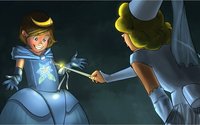Disney's Smart Light Innovations: Adding New Magic To Marketing
- by Chase Martin , June 29, 2016
 Smart lights can communicate with each
other, potentially opening a new door to marketing.
Smart lights can communicate with each
other, potentially opening a new door to marketing.
That’s the essence of smart light innovations Disney Research just showed at an international conference on sensors and networks in London.
The new method of connecting devices in the Internet of Things uses LED lights and doesn’t require a traditional signal, like from Wi-Fi or cellular service.
“I think there’s a huge opportunity in the unknown for us,” Dave Meeker, vice president of Isobar North America, told the IoT Daily.
“It provides a whole new pathway for innovation for people to think of how we can use it,” said Meeker, who also heads Isobar’s NowLab.
Smart LED lights can send and receive data to any device with an LED, as long as they can see each other.
"LED light bulbs mounted on the ceiling or in free-standing floor lamps easily cover a room, serving as illumination while at the same time creating a room-area network that allows data exchange between light-emitting devices," Markus Gross, vice president of Disney Research, said in the presentation.
EnLighting, as Disney calls it, is a network and communication system based on Visible Light Communication (VLC). The idea behind VLC is that LED lights are equipped with technology that controls the frequency and intensity of the light emitted, which is then received as data by any device that can see that light.
Disney is experimenting with adding the lighting capabilities to any existing LED light source.
One example they created is a princess dress with embedded LEDs that light up when an LED-tipped magic wand is pointed at them.
When the wand moves away, the communication between the LEDs stops, causing the lights on the dress to turn off, which can be seen in a video that Disney created.
The variance in light is undetectable to the human eye, according to Disney Research. The idea is that LED lighting systems remain functional, but now become communication devices on top of that.
“I like the idea of leveraging RGB LEDs, which are now in pretty much all of our electronics,” said Isobar’s Meeker. “In some markets, Uber has a colored light in the dashboard. So when I pick my Uber, I pick my color. There could be an opportunity there. Even shopping carts could be read by the lighting system.”
In retail, Philips Lighting has created smart bulbs that don’t require any additional components and can be used to replace existing bulbs. Marketers and advertisers see opportunity in this new communication channel, but how they will use it is still a work in progress.
Beacons also have been used in retail to trigger location-specific messaging and collect various levels of behavioral data. However, adding beacons to retail at scale has been a challenge and VLC lights might be a more practical route, according to Meeker.
“Your phone’s already connected to the network,” he said. “The lights can tell the phone where it is so then the phone can act on that. You still need an app. There are still barriers, but I think it’s an alternative because the technology is a replacement, not an addition. I have to replace the lights anyway, so I can just replace them with smart bulbs.”
Meeker says commercializing won’t be immediate, though.
“There are tons of non-commercial uses that we’ll see first. We’ll see two to three years of experiments and then, once the IP is in a good place, an explosion across all sorts of products and services.”


